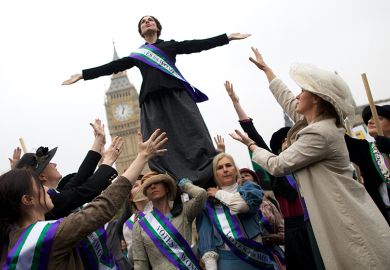E. M. Forster's and Paul Scott's novels about India got it all wrong. British memsahibs did not fear sexual assault from the local men, they were far more at risk from the ordinary British soldier. Nor were these women seething with suppressed desire for Indian lovers. Not only did they find the local men physically unappealing, but the two groups became competitors in the political arena. In their struggle for influence over the Raj's white male ruling class, British women and Indian men tended to regard each other with contempt.
Mary Procida's study of Anglo-Indian (in the old sense of the word) women is full of such original insights and is told with the kind of contagious enthusiasm that derives from the author's knowledge that the sources tell a very different story from the mythology.
Among the cherished myths she slays is the Kiplingesque image of Anglo-Indian women as frivolous and lazy. Their lives were simply outside the metropolitan norms that established women's role as housewife and mother.
Equally convincingly demolished is the philanthropic image of Anglo-Indian women; their husbands were posted far too frequently to allow the memsahibs to devote themselves to serious charitable enterprises, and charity was largely left to the professionals.
What then was women's role in the empire? The author's thesis is that through their attitudes to domesticity, violence and race, women were at the centre of the practices and policies of British imperialism. They were, she argues, active political agents, partners in creating a masculine Raj. In the domestic setting, they oversaw the running of their homes in the same manner that their husbands oversaw the running of a district. They eagerly adopted the use of firearms, which "legitimised their engagement with the politics of empire", and they were among the most hardline supporters of the imperial project, contemptuous of Gandhi and less accepting of India's eventual independence than were their menfolk.
This is a stimulating line of inquiry, and the result is an important work, exceedingly well written and highly readable, one that avoids simplistic conclusions and never loses sight of the wider context. Full of fresh insights, it is a study that will be particularly enjoyed by students.
But the category of Anglo-Indian women might have been more carefully defined. How were these women educated and what social and intellectual influences did they bring with them? What of separation, divorce, even suicide? Given the focus on wives of the Raj's officials, can we apply these conclusions to non-elite wives?
More important, the author fails to provide specific examples of women actively and directly influencing imperial politics. What of the frontiers, where women were generally excluded and where even in the 20th century policy might be made "on the spot"? Women had little or no influence there. The officials of the Raj guarded their power jealously. They were as reluctant to share it with women as they were to share it with Indians, British "lower ranks" and anyone else from outside their own narrow circle.
Alex McKay is a research fellow in history, School of Oriental and African Studies, London.
Married to the Empire: Gender, Politics and Imperialism in India, 1883-1947
Author - Mary A. Procida
ISBN - 0 7190 6073 7
Publisher - Manchester University Press
Price - £47.50
Pages - 246
Register to continue
Why register?
- Registration is free and only takes a moment
- Once registered, you can read 3 articles a month
- Sign up for our newsletter
Subscribe
Or subscribe for unlimited access to:
- Unlimited access to news, views, insights & reviews
- Digital editions
- Digital access to THE’s university and college rankings analysis
Already registered or a current subscriber?



